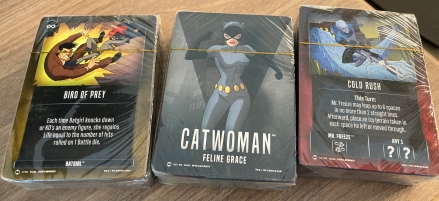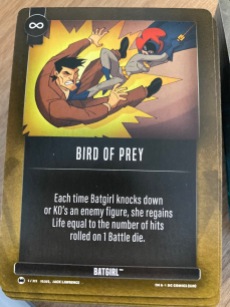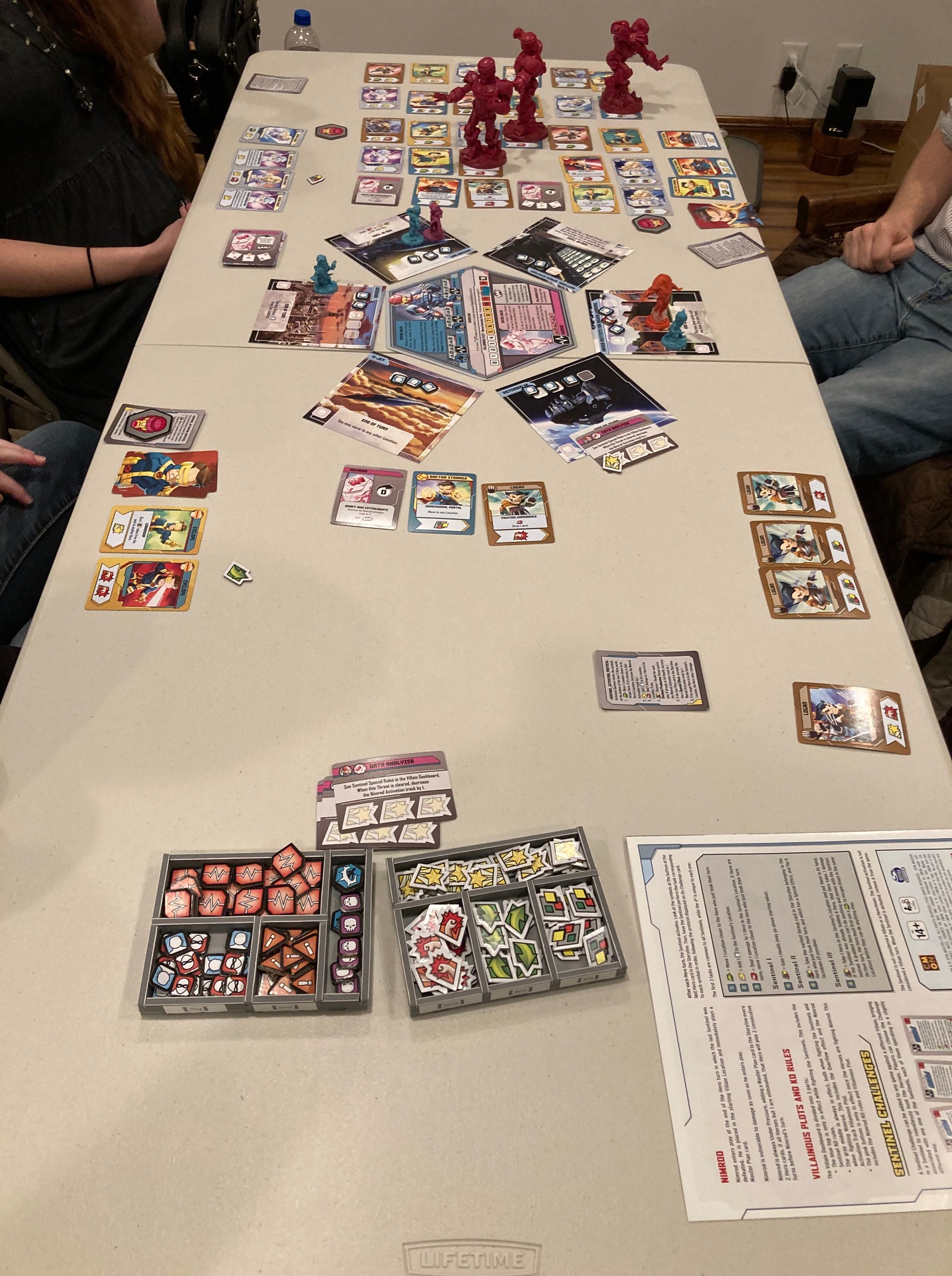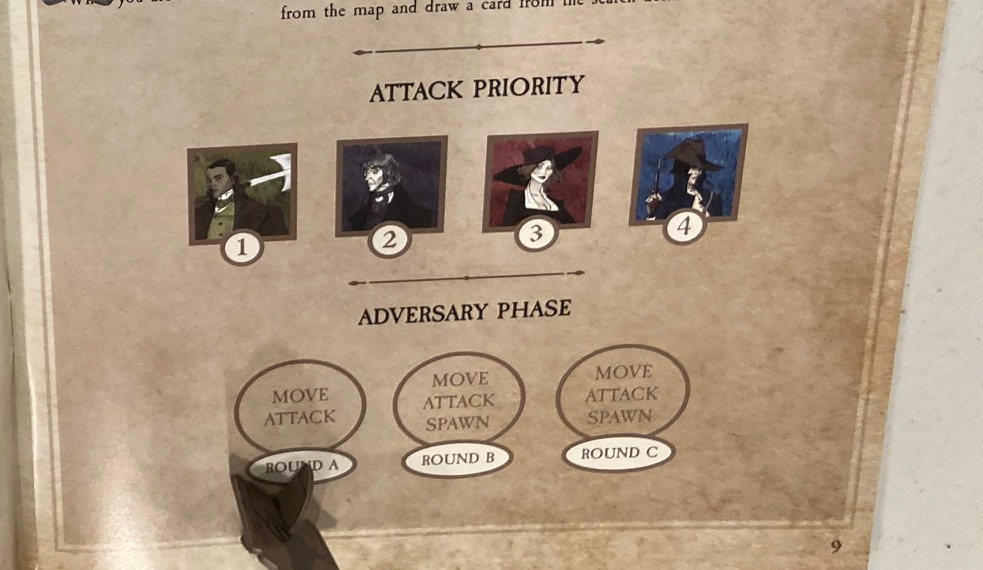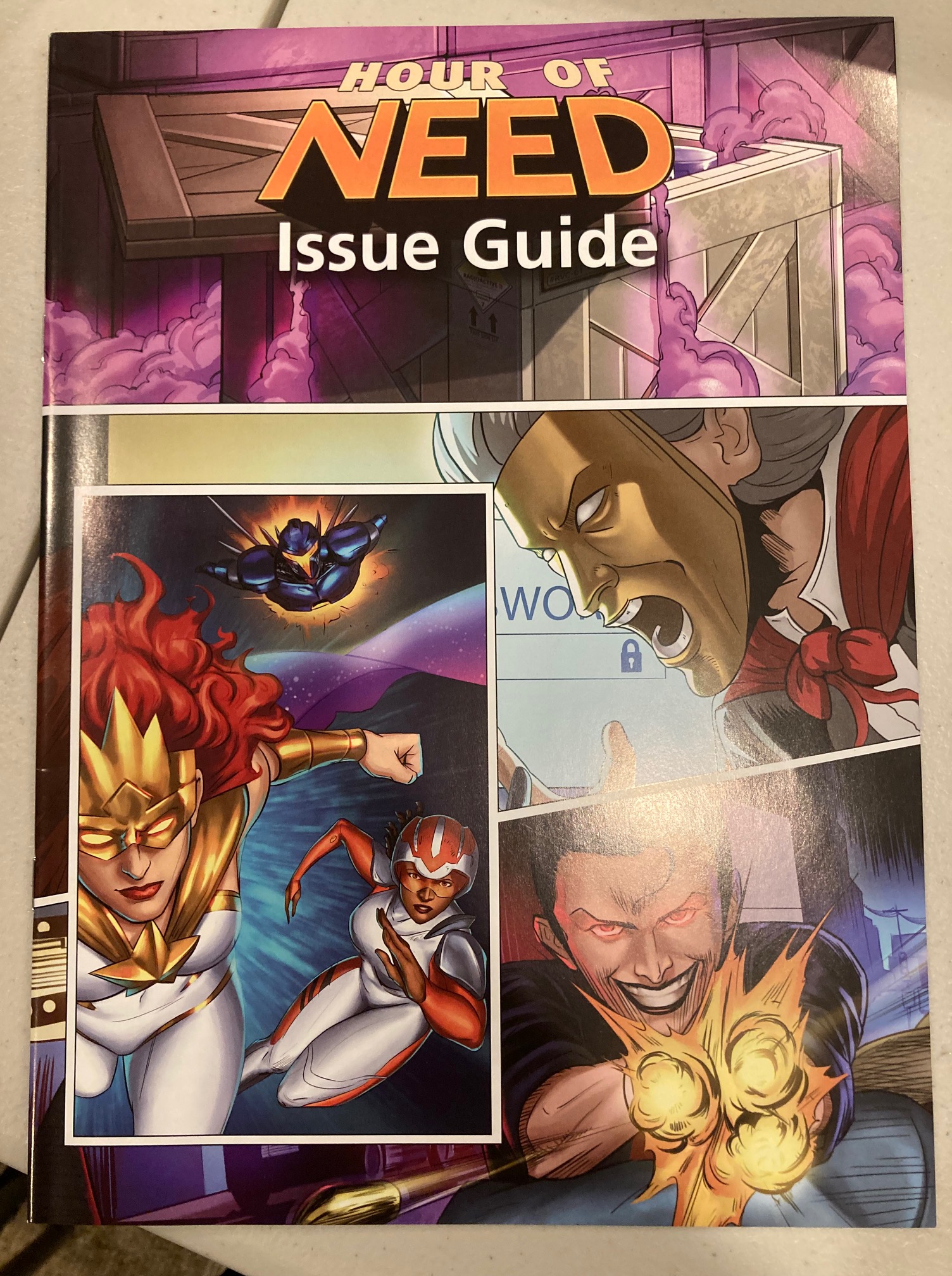
Let’s be clear here: there are at least two cooperative Batman The Animated Series games: Gotham Under Siege and Shadow of the Bat. This week, we are focusing on the Pete Walsh and Kevin Wilson design called Shadow of the Bat (see picture above). Gotham under Siege (see picture below) is a fantastic Batman game that made our Top 10 Cooperative Dice Games and Top 10 Cooperative Superhero Games. Gotham Under Siege is a different dice game that we will discuss again later: these two games will have some unexpected crossover!! What does that mean? Keep reading fearless reader!

Kickstarter

Batman The Animated Series: Shadow of the Bat (sometime called Batman: The Animated Series Adventures) is a cooperative and competitive Batman game (yes, it’s both, but we are only looking at the cooperative mode) that was on Kickstarter back in March 2020, with promised delivery in December 2020. They did not make this date: I believe they delivered in early 2022: I only know this because I picked up the game online after it delivered. The original Kickstarter price was just too much money for me to be all in, so I chose to wait until it was cheaper online! I wanted to see what the game was like before I threw $300 (!) at it.
This Kickstarter is of historical significance in many ways: IDW decided to stop making games altogether recently, and this will probably be the last Kickstarter game IDW ever does! Those of you paying attention might remember a list we had up in late 2021: Top 6 Cooperative Games To Grab Before IDW Games Disappear Forever!! Number 2 on this list was Shadow of the Bat! To be fair, we expected Shadow of the Bat to be a good game (it’s a Kevin Wilson design, one of our favorite designers), but we hadn’t actually played it yet. Let’s take a closer look.

We are going to do this a little differently than normal, only because it took us a while to get into the game: we are going to divide this into days (really, one session per day) over which we explored the game.
Day 1: Unboxing

On a recent trip to Denver, I brought Shadow of the Bat with me, hoping to play it with my friends. For many reasons, it never came out. One reason was how big and ominous this game is! It’s bigger than a normal box (see Coke can above for scale) and it has quite a number of components.

It’s got quite an array of tokens: I mean a LOT of tokens! It’s the first thing in the box!

Look at how thick that is! There are SO MANY TOKENS to punch out. Foreshadowing: we will have to spend an entire session/day to JUST punch out and organize the tokens.

One of the coolest things in the box are the miniatures! There’s quite a number of them! See above.


There are also a quite a number of terrain boards. If you think this is starting to look like a skirmish miniature game, you wouldn’t be wrong.
Underneath all the minis and terrain boards and punchouts are the cards and dice. Oh yes, this is a dice game! Each player will have a set of 3 dice and the remaining dice are “battle dice”.


The rulebook is quite thick (we’ll take a closer look later) and the game also comes with two whole scenario books for 12 issues of set-up. The rest of the game is in the cards! See below.
The cards look very consistent with art from Batman The Animated Series.

After unboxing the game to try and play it, I chose to wait until I got home to finish unpunching the tokens. There were SO MANY TOKENS, I knew they would just all clunk around in my luggage if I punched them out in Denver. So, Day 1 was just getting acclimated to the components.
Day 2: The Unpunching

There are a LOT of tokens. I thought my next session would be a solo playthrough. I was wrong! I spent the entire session unpunching. See all the tokens above and below.

In the end, I chose to punch tokens out in clumps: the rulebook describes all the tokens on one page of the rulebook, so I tried to punch out tokens in the groups specified: See below.

You will also happen to notice there were NO CORRELATING PICTURES for the tokens. I had to kind of guess what was what. I was very grumpy at this (we had similar problems in Deep Space D6), but I did find some token descriptions in the back pages of the rulebook: See below.

So, before you go absolutely crazy, make sure you poke your head in the back of the rulebook as you punch out tokens: quite a few of them have correlating pictures.

In the end, I chose to store the tokens in bags in the same groupings they were described in the rulebook: I used a sharpie to write on the bags (see above) to notate what was inside. (For the record, I had to do that thing we hate: I had to count the number of tokens to make sure I had the right kinds … there still weren’t quite enough descriptions).

This bears emphasizing: there were a lot of tokens.
After spending a few hours putting all the tokens together, I was done. Gameplay would have to wait for another day.
There are so many tokens, they almost don’t fit in the box! See above.
Day 3 Interlude: The Miniatures

I took a brief Interlude day to just play with the miniatures. I tried a couple of stands to see how they worked:
In the end, the minis are fairly distinct and I could use the little yellow stands that came with the game.

The minis are pretty good.

The lighter plastic makes them easier to distinguish than the Hour of Need minis (from a few weeks ago).


I like the minis. They work pretty well and look pretty good on the board.
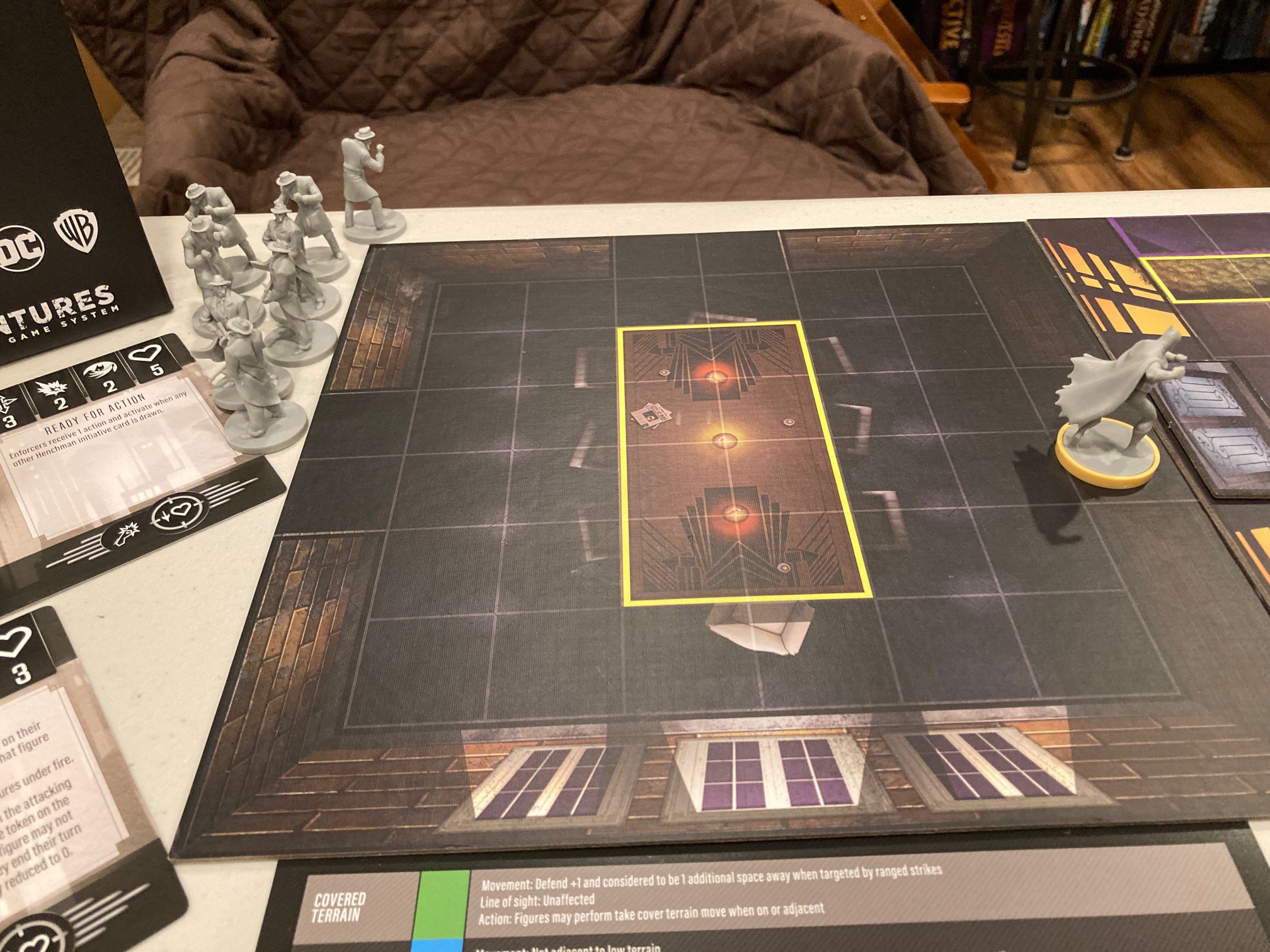

Day 4: First Solo Play
I finally got the game set-up! I even played through it. And I got so many rules wrong. But, it was good to try to get through the first game to get a sense of everything, at least of the main flow. I won, but it was a huge cheat: I missed so many rules.
Day 5: Second Solo Play, First Correct Solo Game
Okay, after an unboxing, getting familiar with the components, unpunching the tokens, playing with the miniatures, reading the rulebook, and getting a bad play under my belt, I finally played a proper solo game! And you know what, it was fun. It just took a long time to get there.
Rulebook

This rulebook is pretty okay, but it feels really long (well, because it is). I almost felt like I was reading a rulebook for an RPG!

There’s a nice chapter listing right up front, but there is no Index: seriously? Did we not learn anything from Hour of Need ‘s lack of an index last week? Indices are critical for complex games like this. But at least this rulebook has many glossaries (se below)! So they do get points for that.

The game is both competitive and cooperative: the rules for both are interspersed among each other, which made it a little more difficult to deal at times.

The next few pages have components. They do commit the cardinal sin of not having pictures immediately with the list of tokens, but they make up for it by having a lot of those pictures in the glossaries and the next few pages.
There are a LOT of components in this game.

This rulebook is pretty okay. It’s long, the competitive/cooperative sections are well-labelled, but sometimes annoying that the two sections are interspersed with each other.
The rulebook’s only real sin is not having an index. The rest of it is … okay. The rulebook tends to label things and have decent examples. This is just a big game with lots of rules, so it’s easy to get lost in the rules sometimes.
Seriously, I felt like I was reading rules for an RPG (“Rules for crouching? Smoke? Doors?”).
Solo Play
Yes, Shadow of the Bat game has a special set of rules for solo play (congratulations on following Saunders’ Law). I admit I was a little worried at first, because the scenarios I looked at always seem to a need 4 characters!! Was I going to have to play 4 characters all the time? Thankfully no.

Actually, the real problem is that the solo mode is not called the solo mode: it’s called The Dark Knight Mode!!! Once you realize that The Dark Knight Mode is the solo mode, you are happy that it’s only two pages of extra text with few extra rules. Basically, the solo player plays the lone character Batman (only one hero). The extra rules: Batman gets to act three times during a full turn (normally, each hero character only gets to act once), gets a few bonuses on abilities, always gets an extra wild symbol, and has one extra ability card (which allows him to heal focus: see below).

I’m always very nervous when solo modes are outside of the main flow (Marvel United has such a contorted solo mode), but the extra rules for The Dark Knight Mode were easy to understand. Better yet, these extra rules were readily notated with the extra card (see above) and and cardboard augment (see below): these two extra physical components remind the players of most of the extra rules!! And these new rules were straight-forward to assimilate into gameplay. Honestly, I was very pleased with how well the solo play was described and notated.

As I said earlier, my first play was pretty much a disaster, but I don’t blame the solo mode: Shadow of the Bat simply has a lot of rules.
My second solo play went a lot better once I had a better feel for the components and rulebooks and basic game flow.

I will say this: I had to have the rulebook open the entire time: my nose was pretty much buried in the rulebook as a I played.
I liked the solo play.
Dice Game

Despite all the minis and rules, Shadow of the Bat is (at its core) a dice game.
Each player assumes the role of a character (Batman, Robin, etc) and each character gets their own three Action Dice. These dice dictate what actions the character can do that turn: Move, Melee Attack, Ranged Attack, Defend, sometimes both, and a Special. If you don’t like what you roll, you can spend a Focus token to re-roll dice you don’t like, but you can only do that once. These Action Dice dicate what you do on your turn: you “spend” each die to something on your turn.
If you do decide to attack something, then you roll the Attack Dice (black dice below): These decide how many hits you get.

You get 1 hit, 2 hits, or a Defend. Like the Action Dice, you can re-roll Attack Dice by discarding a Focus.
Dice decide most things in this game.
Cooperative Play

One of the more interesting things of the cooperative mode are the way dice work: you share one of your dice with your left neighbor and another dice with your right neighbor. It kind of reminds us of Marvel United meets Second Wonders where you “share” your Actions with your neighbors.

To do that, you roll your three dice and choose 1 for each neighbor: Having decided which dice face to give to each neighbor, you then give a little token (Dice Placement Token) to your neighbors to notate what “extra” actions they get. See below.


What this means in reality is that you get 5 actions per turn (3 from your dice and 2 from your neighbors).

This really reminded me a lot of a cooperative Seven Wonders or Marvel United, where you are sharing your symbols with you neighbors. This did encourage cooperation among me and my neighbors, but not as much as I expected: as a player, you are trying very hard to get your own symbols, so you are trying to decide to re-roll at the same time as your neighbors. In practice, you tend to roll in isolation and then share a symbol if you neighbor wants it! Still, it worked reasonably well.
Scaling and Player Counts

One of our least favorite parts of this game was the player scaling for 3 players. While the solo game works great (with the player playing Batman and getting 3 initiative cards), the multiplayer game always requires 4 characters to be in play! For a 4-player game, this is perfect (as each player takes control of one character). In a 2-player game, each player takes control of two characters each: this can be daunting for beginners but at least it’s balanced. But, as we saw in the 3-Player game (above), we didn’t love the flow of one player controlling two characters while everyone else only controlling one. It felt like you had to wait longer for your turn, and the flow just seemed “off”.

If you DO play 3 players, make sure that the player taking control of Commissioner Gordon does NOT get the extra fourth character! Gordon already has to deal with putting his beat cops out!! See above. The rules already recommend the 4 characters to play: maybe they should recommend how to divvy the characters in a 2 or 3 player game?

We have seen some games (like Legends of Sleepy Hollow, see our review here) that always require 4 characters, and that didn’t always quite work. Luckily, Shadow of the Bat has a great solo mode that avoids some of the issues Legends of Sleepy Hollow had. So: 1, 2, and 4 players works well enough: 3-Player can work, but it was by far our least favorite player count.
Miniatures Game

Looking at the set-up above, you might guess this is a tactical and strategic miniatures game with RPG elements. And you would be right! There are so many rules surrounding the miniatures and the map that this game reminds me of a miniatures game more than a strict board game. The game is all about moving the minis and the actions on the map. There are some items to help and some abilities, but Shadow of the Bat is really all about moving around the board tactically to beat up bad guys.

Compare this to Hour of Need a few weeks ago (which we reviewed here): Hour of Need (see above) is very similar to Shadow of the Bat in many ways. Each player takes the role of a Superhero, the game has a tactical map, players roll dice to hit, and heroes move around beating up bad guys. This is all very similar to Shadow of the Bat! The main difference is that card play is the central mechanism in Hour of Need! There are so many ways to use/interact with the cards of the game, and you absolutely have to use the cards as much as possible if you want a chance of winning!

Shadow of the Bat is much more about moving the minis in tactical and strategic ways … almost like a war game. Sometimes you move to be defensive, sometimes you attack, sometimes you lure other people away. There are so many rules and tokens for dealing with things on the miniatures map: crouching, smoke, doors, bombs, etc etc etc.
Shadow of the Bat is a miniatures game set in a world of Superheroes, with lots of thematic elements. Hour of Need is a very thematic Superhero game with card play, which just happens to have miniatures and a map. If you see the difference.
Choice vs Randomness

To be clear, I like this game. I think I like it more solo than cooperative, but in general I am keeping this game.
However, here’s my main problem with the game: you roll dice to decide your actions. You don’t get to choose: the dice determine what you get to do. For a game with so many rules and so much set-up, you don’t get a lot of choice because you have to take what you get when you roll. Now, this can be mitigated by a re-roll (but only one re-roll and at the cost of the a Focus token), and you can get actions from your neighbors (but only in cooperative mode). But, at the end of the day, you may not get to do what you want. And that’s frustrating.

For some reason, I don’t have as much an issue with this same dice system in the Reckoners: Just like Shadow of the Bat, The Reckoners only allows you to do what you roll. But there’s several differences: In The Reckoners, you get to re-roll up to three turns for free! AND you can roll in any order you want (Player Selected Turn Order) as you re-roll! AND you can always do something with your dice! AND one dice face is a future wildcard!! The dice mitigation is much much higher in the Reckoners: you can usually do something interesting. And The Reckoners is much simpler than Shadow of the Bat: it’s just a dice game that won’t last all night. Shadow of the Bat is supposed to be a much deeper game, but I feel like this dice action mechanism holds it back a little.

And while The Reckoners has Player Selected Turn Order, Shadow of the Bat has the random Initiative Order (see above) that we saw in Aeon’s End and Adventure Tactics, where it’s possible to be completely shutout. See Seven House Rules for Cooperative Board and Card Games: Curb Excessive Randomness.
Players Choose

Just last week, I was lamenting that a lot of cooperative games use “let the players decide” when ambiguity shows up. Shadow of the Bat uses “let the players decide” in a number of places. For one, there is no order of how the Bad Guys attack.

Consider the map above: When the dudes with Machine Guns(above) come up in initiative order, in what order to they attack? How do they move? There’s notions of both, but especially when they are this clustered, the players will have to make a lot of edge case calls about how they move. It’s not a big deal (you get used to it and it worked pretty well honestly), but some people may really not like this.
I admit I was excited when I saw that each Bad Guy had a “preference” of who they attack! See the bottom of the cards above: the up-arrow heart means those Bad Guys prefer to attack players with the most hit points! The down-arrow heart means those Bad Guys prefer to attack lowest hit-point heroes. But just like most cooperative games, whenever there was an ambiguity, Players Choose. I got all excited because I thought, for a moment, there was a more ambitious ambiguity resolution mechanism.
One other issue: how do we keep track of how many Hit Points each Bad Guy has? I ended up choosing to put the hit points “under” each Bad Guy, but I wish there were a better mechanism. (My friends also thought that was a major flaw).
The Arkham Horror Connection
Both Batman games from IDW are by the two co-designers of Arkham Horror Second Edition: Kevin Wilson designed Shadow of the Bat and Richard Lanius designed Gotham Under Siege. They are both Batman games, both cooperative games, both fundamentally dice games, and both in the Animated Series universe. Which is better? I think Gotham Under Siege is lighter and easier than Shadow of the Bat, and frankly it’s easier to get to table: I think I like Gotham Under Siege better (even though it’s fundamentally a random dice game): it’s just quick and easy and doesn’t outstay it welcome. I do like Shadow of the Bat, but it’s a much longer and heavier game. Sometimes the randomness of the dice in such a heavy game is a little out of place.
Conclusion

I like Shadow of the Bat, but I suspect a lot of people won’t. This feels like a big tactical miniatures game with tons of interesting rules, but the limited dice mitigation and random player order feels out of place in a game with so many rules. The randomness can just beat you down. I think Hour of Need is the better overall Superhero game: there are so many choices and upgrade paths in that game that players always feel like you can do cool superhero stuff. In Shadow of the Bat, player actions are limited by what they roll on the Action Dice. Having said that, Shadow of the Bat can be very cool as a puzzle game, where limited actions form the constraints of the puzzle (players do the best you can). Like I said, I really enjoyed this game solo.
Shadow of the Bat is a cool miniatures game that dwells on the map and tends to be less about being a Superhero game and more about being a cooperative/solo tactical minis game. I like it: it will come out when that’s what I want. Your mileage may vary.


